Looking for an easy-to-use yet effective way to help your body as it ages, ease pain, and improve how your joints work? Mini resistance bands are what you need. Despite their small size, these bands are powerful in boosting your health. They’re perfect whether you’re healing from an injury, aiming for better balance, or just want a flexible exercise option. Mini resistance bands help create resistance when stretched, focusing on gradually strengthening specific muscles. Adding these bands to your workout can ease pain, improve joint mobility, and enhance overall balance and stability.
What is a Mini Resistance Band?

A mini resistance band for exercises is a compact, shorter version of a regular resistance band primarily designed for strength training. Its smaller size makes it ideal for targeting specific muscle groups, particularly in the lower body, with exercises such as leg raises, glute bridges, and lateral leg lifts. Mini bands provide a lighter resistance, making them suitable for individuals looking to tone and activate muscles without excessive strain.
On the other hand, regular resistance bands, being larger and more versatile, cater to a broader range of exercises, including upper body workouts like bicep curls and shoulder presses. Both types contribute to effective strength training, but the choice depends on individual preferences, workout goals, and the muscle groups targeted in a given exercise routine.
Benefits of Using Mini Resistance Bands
Mini resistance bands, or mini loop bands, provide numerous advantages for individuals at any fitness proficiency level. Here are some of the key advantages:
1. Versatility:
Mini resistance bands can be used for various exercises targeting different body parts, including legs, hips, back, arms, and shoulders. They’re suitable for strength training and flexibility exercises and can be integrated into various workout routines.
2. Portability:
Due to their small size and lightweight nature, mini resistance bands are highly portable. These are conveniently portable, ideal for exercising at home, at the gym, or during trips, as they fit neatly into a bag.
3. Cost-Effective:
Compared to other fitness equipment, mini resistance bands are relatively inexpensive. They provide a cost-effective way to add resistance training to your fitness regimen.
4. Suitable for All Fitness Levels:
Whether you’re a beginner or an experienced athlete, mini resistance bands come in different resistance levels to match your fitness level. You can modify the workout intensity by selecting a suitable resistance band.
5. Injury Prevention and Rehabilitation:
Mini resistance bands are commonly used in physical therapy and injury rehabilitation. They help strengthen muscles, improve flexibility, and can be crucial in recovering after an injury.
6. Enhances Exercise Efficiency:
Adding resistance bands to your workouts can increase the effectiveness of the exercises, challenge your muscles in new ways, and promote muscle growth and strength.
7. Improves Coordination and Balance:
Many resistance band exercises require core stability and balance, which can improve overall coordination and balance over time.
8. Adds Variety to Workouts:
Using mini resistance bands can add variety to your exercise routine, helping to keep your workouts interesting and challenging, which can be beneficial for maintaining motivation and progress.
Incorporating mini resistance bands into your fitness routine can offer a convenient, versatile, and effective way to enhance your workouts, improve your physical health, and achieve your fitness goals.
How Do Mini Resistance Bands Help in Alleviating Pain?

Mini resistance bands offer a targeted and effective way to alleviate pain through low-impact strength training and rehabilitation exercises. By engaging in consistent resistance band workouts, you can strengthen the muscles surrounding your joints, which enhances stability and reduces the burden on the joints themselves, thereby alleviating pain. These bands are particularly beneficial for areas prone to discomfort, such as knees, hips, and the lower back.
The versatility of mini resistance bands allows for various exercises that can be adapted to any fitness level, ensuring that individuals can gradually build strength without exacerbating pain. Additionally, the exercises promote improved circulation, which aids in healing and reduces inflammation in affected areas. Regularly using a mini resistance band for exercises can also improve flexibility and range of motion, further contributing to pain relief and reducing the risk of future injuries by ensuring muscles and joints function optimally.
Improving Balance with Mini Resistance Bands
Maintaining balance becomes increasingly important as we age to prevent falls and injuries. Mini resistance bands can significantly improve balance and stability by targeting the muscles responsible for maintaining equilibrium.
When you use mini resistance bands for exercises that challenge your balance, such as single-leg squats or standing hip abductions, you engage the muscles of your core, hips, and legs that are essential for balance. The resistance provided by the bands adds an extra challenge, forcing these muscles to work harder and enhancing their strength and stability.
Improving balance reduces the risk of falls and injuries and enhances overall athletic performance. Whether you’re an athlete looking to improve your performance or an older adult aiming to maintain independence, incorporating mini resistance bands into your workout routine can help you achieve your balance goals.
Different Exercises You Can Do with Mini Resistance Bands
Mini resistance bands are incredibly versatile and can be used for various exercises targeting various muscle groups. Here are a few mini-band exercises you can incorporate into your workout routine.
1. Single Knee Half Circle:
In this exercise, use the back of a chair or a wall for balance if needed.
Begin in an upright standing position with your feet hip-width apart, maintaining good alignment with your head, shoulders, hips, and legs. Loop the mini band around your legs, just above your knees. Place one hand on the back of the chair for support. Engage your core and shift your weight onto one leg. Raise one knee towards your chest, ideally to a 90-degree angle. Rotate your knee out to the side and back down to the center position to return to the starting position. Repeat the movement.
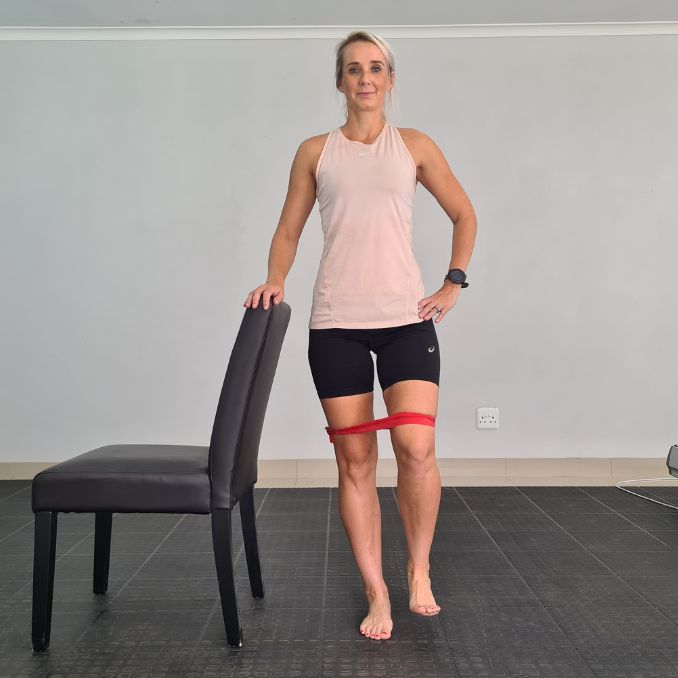 |
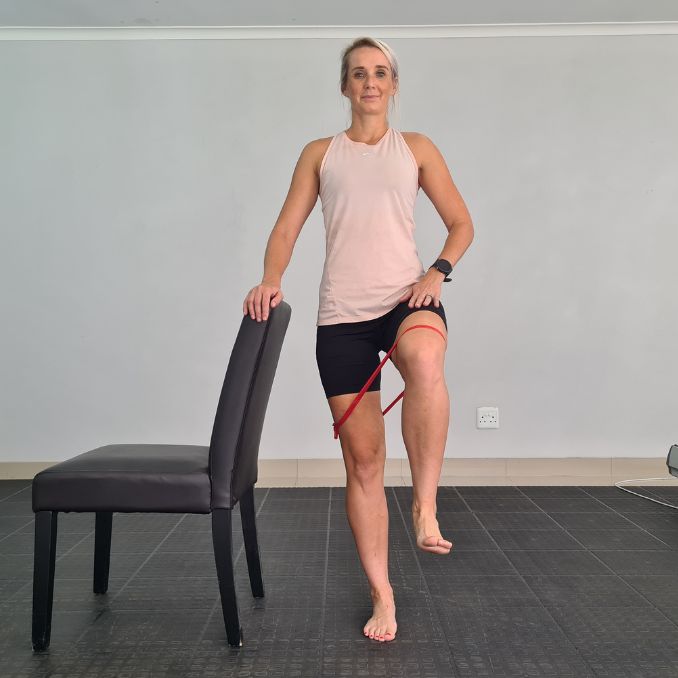 |
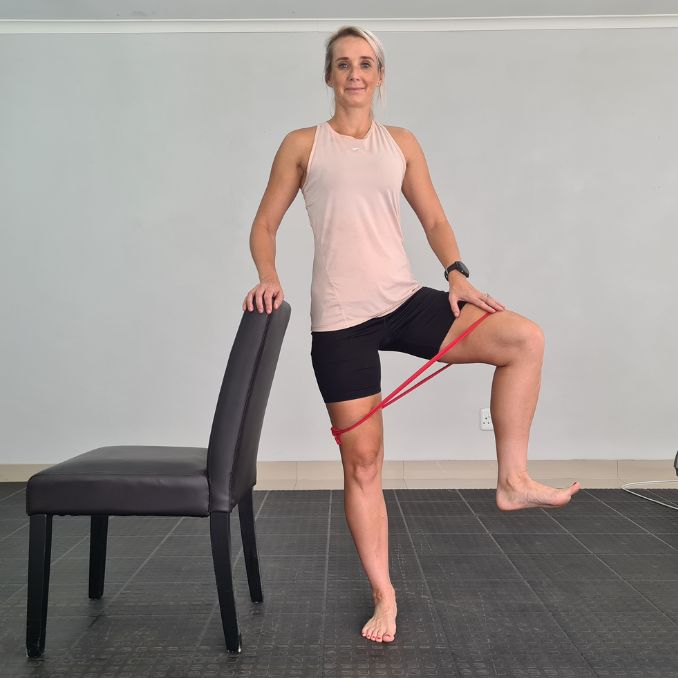 |
This exercise targets hip mobility and stability, effectively engaging the core and leg muscles.
2. Banded Lunge
Begin in an upright standing position with your feet hip-width apart, maintaining good alignment with your head, shoulders, hips, and legs. Loop the mini band around your legs, just above your knees. Place your hands on your hips. Take a big step forward with one foot and bend your front knee directly over your ankle, straightening your back leg as you stack your back heel over your toes. Tighten your abdominal muscles as you shift your pelvis forward, pressing through your back toes. Hold this position for several deep belly breaths, in through your nose and out through your mouth. Return to the starting position and repeat the movement on the opposite side.
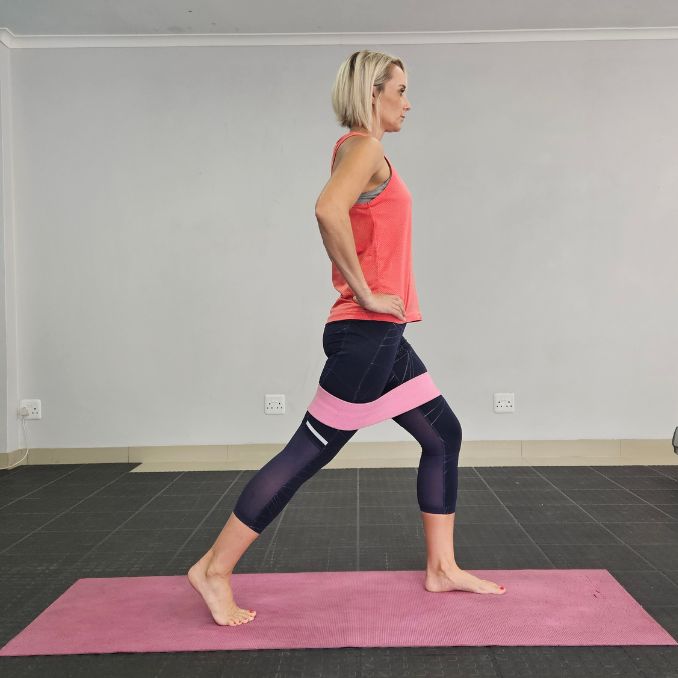 |
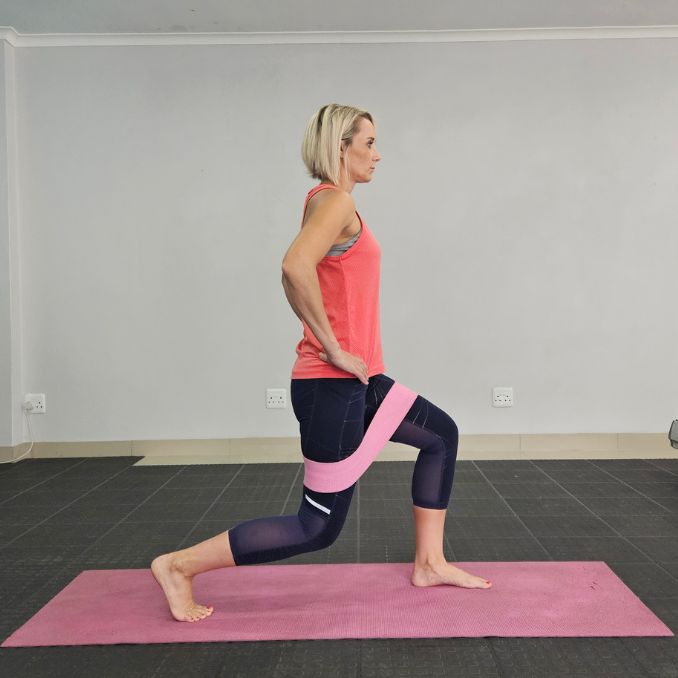 |
3. Side Steps with Band
Begin in an upright standing position with your feet hip-width apart, maintaining good alignment with your head, shoulders, hips, and legs. Loop the mini band around your legs, just above your knees. Place your hands on your hips. Engage your core and take a big step to the side with one foot, following with your other foot. Repeat the movement, alternating sides.
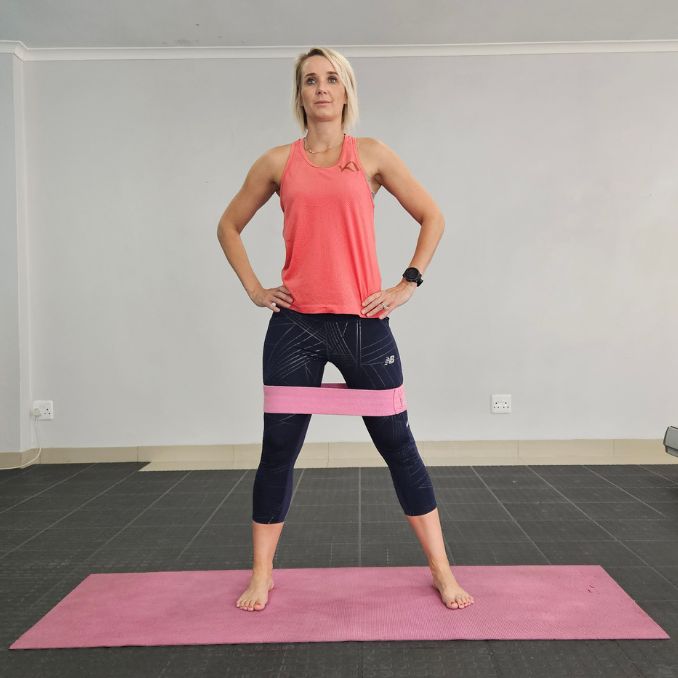 |
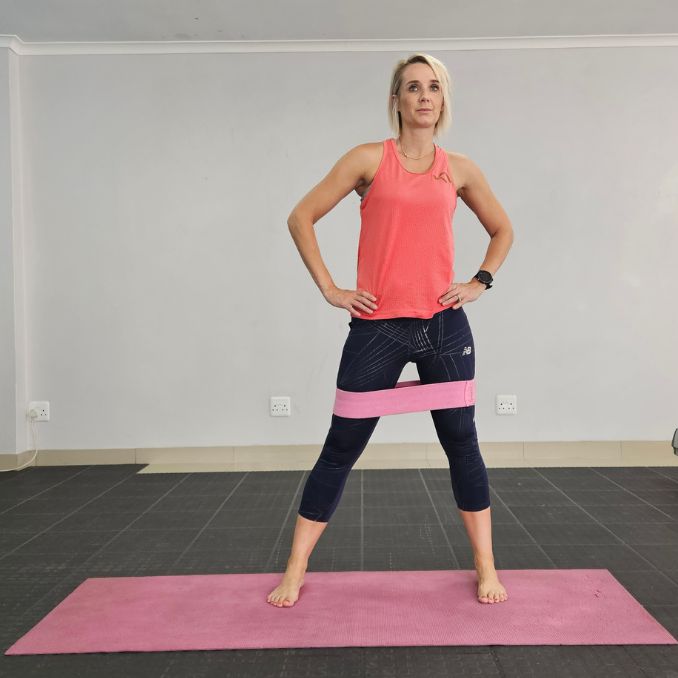 |
4. Banded Squats
Begin in an upright standing position with your feet hip-width apart, maintaining good alignment with your head, shoulders, hips, and legs. Loop the mini band around your legs, just above your knees. Bring your hands in front of your body at chest height. Contract your core, bend your knees, and hinge through your hips to move into a squat position, ideally bringing your knees to a 90-degree angle. Raise back up to return to the starting position and repeat the movement.
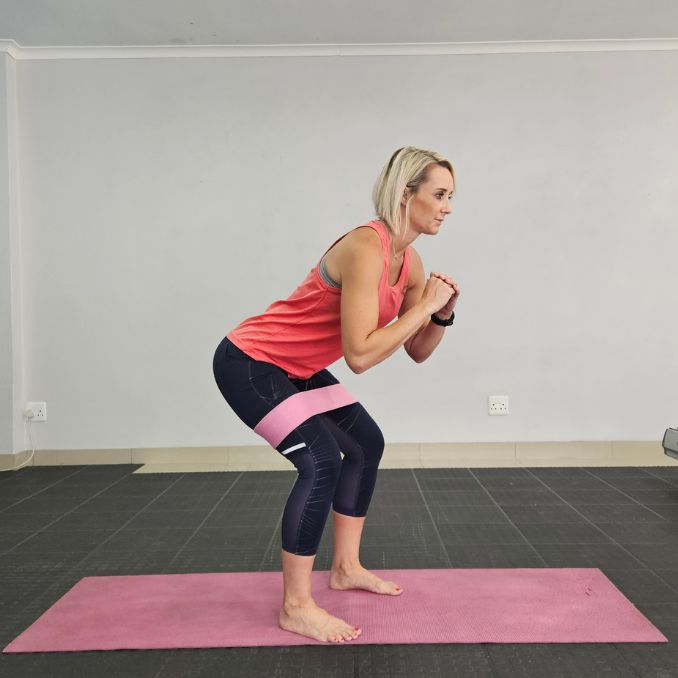 |
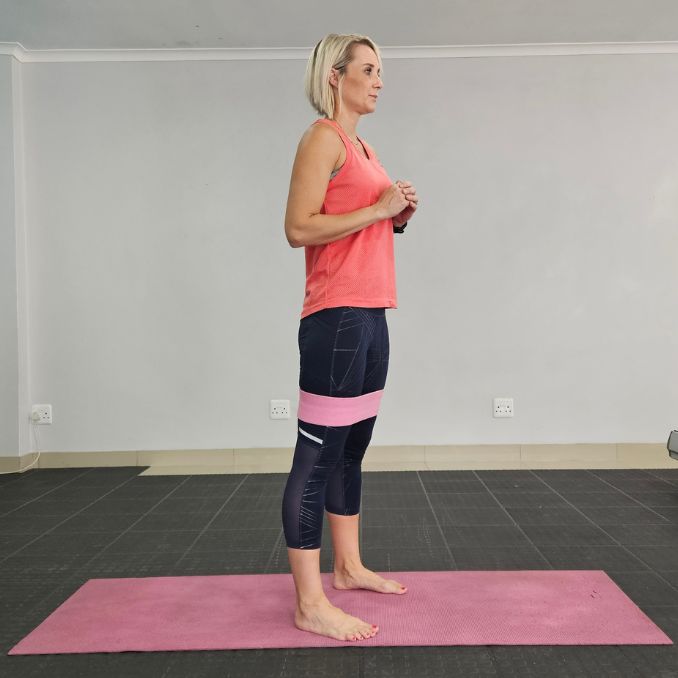 |
Conclusion
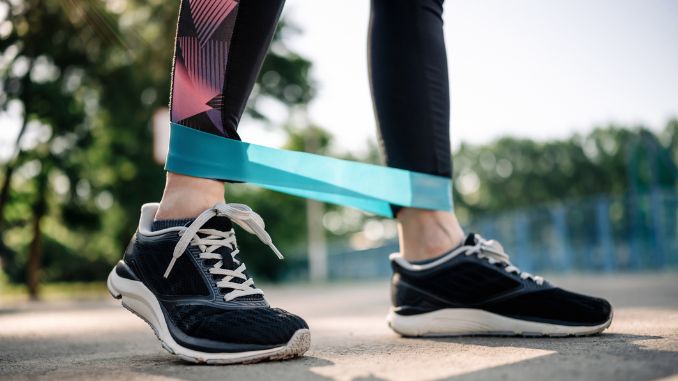
Incorporating a mini band into your exercises makes a difference, especially if you want to ease pain, make your joints work better, stay balanced, and keep your body strong as you age. These little bands are powerful tools that help focus on specific muscles, boosting stability and movement. They’re great for various exercises, fitting anyone’s fitness level or goals. These bands can lessen pain and improve joint health, balance, and stability. Ready to tap into your strength and support your body as it ages?
Give mini resistance bands a try in your exercise routine and see how they can positively affect your health. Start with simple mini-band exercises, build up slowly, and feel the good changes they bring to your fitness journey.







